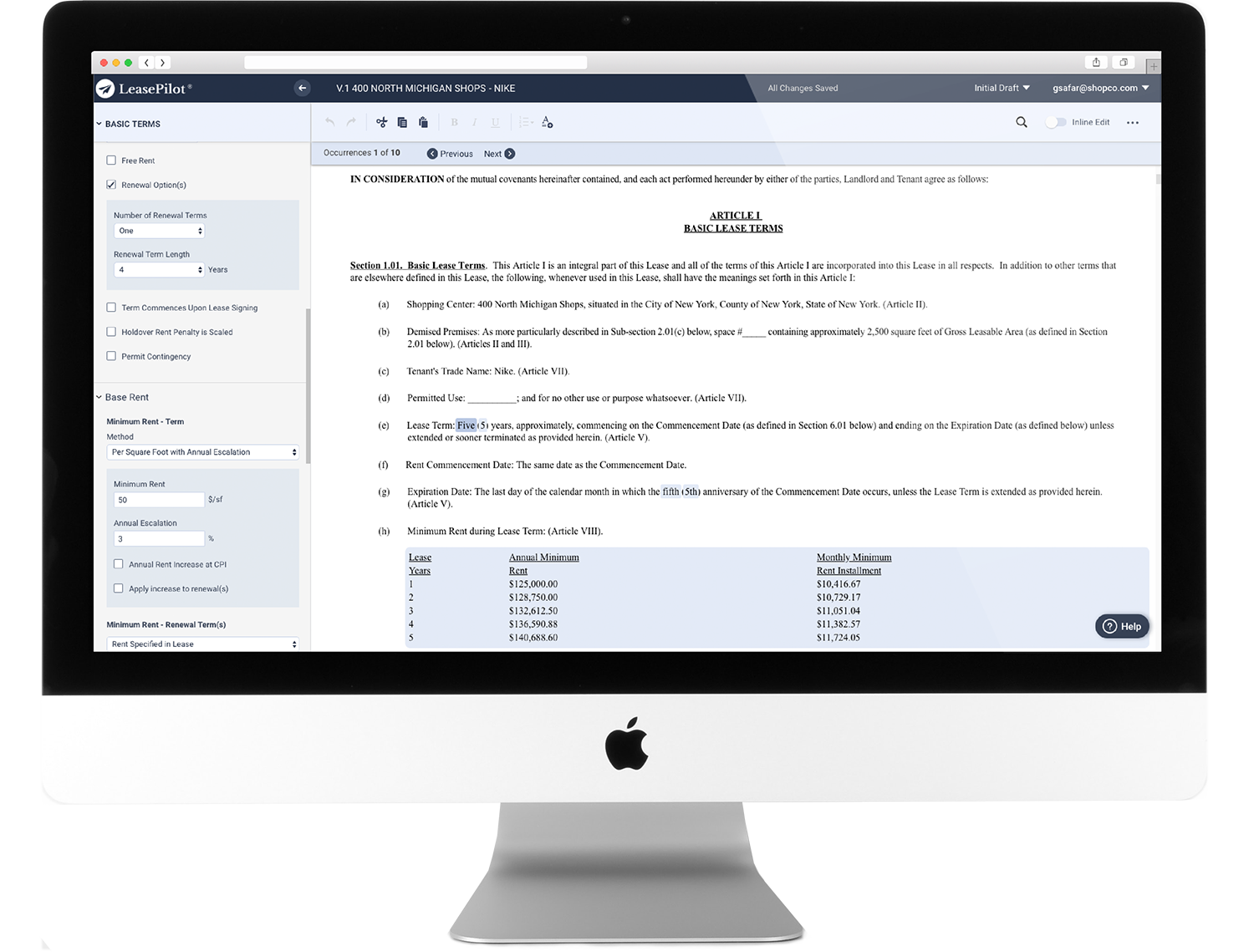“How does LeasePilot actually work?”
“What’s the difference between LeasePilot and other document automation tools like A, B, and C?”
These are questions we get all the time, and answering them in a way that is clear, concise, and not overly-technical is a challenge. LeasePilot doesn’t quite fit into an existing product category, so descriptors like “document automation” don’t accurately convey what we do or differentiate us from what’s out there already. By building a platform that reinvents the leasing process, we’ve found that we also need to reinvent the language used to describe what it is we do.
A note: The next few sections probably won’t say anything that those in the CRE industry don’t already know. But they’re an important read as they lay the groundwork and set the context for the information that follows.
What is a lease?
A broad definition of a lease might be, “A legally-binding document that describes/defines the relationship between a landlord and a tenant.” While that’s true, it’s not very precise. Let’s dig a little deeper.
An executed lease contains various “hard terms” which have objective, often quantifiable meanings. Things like rent, commencement dates, CAM charges, etc. are examples of this. Although all leases will inevitably contain some subjective language, both the tenant and the landlord strive to eliminate these instances whenever possible. As a result, the overwhelming majority of the terms in a typical commercial lease are objective and straightforward.
A lease, then, can be thought of as a means to organize all these terms into a single, legally-binding document in a familiar format.
Negotiation
Once a tenant and leasing rep reach a tentative agreement, the terms are recorded in an LOI. It’s at this point in the process that leasing reps hand things off to the legal department and a first draft is generated.
First drafts are generally straightforward as they’re a re-statement of the LOI in a formal document. Because they’re so predictable, legal teams often use some level of automation to generate initial drafts. In a more traditional workflow, this is usually done by opening a base lease form in Word, referencing the LOI, and copying/pasting the necessary language from an existing library.
By building a platform that reinvents the leasing process, we’ve found that we also need to reinvent the language used to describe what it is we do.
In more modern workflows, document automation and/or contract management software is used to generate a first draft. Usually this means typing tenant and asset info into an MS Word plugin and then selecting relevant language from a searchable library (LeasePilot does this somewhat differently, but we’ll cover that shortly). Form inputs and selections are then automatically assembled and formatted in an MS Word document.
If traditional automation software could speak to the user, it’s at this point that it would say, “Ok, I’ve assembled the first draft. You’re on your own now.” If any custom language is needed, a lawyer will manually add or change the text right in MS Word.
As soon as the tenant’s lawyers get their hands on the first draft and the red pens (real or digital) come out, things start to get messy. With no further automation tools at their disposal, lawyers are left to process 2nd, 3rd, and nth drafts by hand in MS Word.
This brings us to an important question: Why aren’t standard document automation platforms equipped to handle a leasing process with multiple rounds of revision and negotiation? What’s so different about the nth draft that it can’t be automated?
Interconnected terms
A commercial lease is full of what software programmers and product managers would call ‘dependencies.’ As a simple example, consider the commencement date: if the commencement date changes, what other parts of the lease also need to change? In other words, how many other parts of a lease are dependent on the commencement date? Expiration, option notices, free rent schedules and letter of credit burn-downs to name a few.
Further, if landlord work is introduced during negotiation, a “hard” commencement date often becomes a “soft” one, and all the dates in the lease will need to be changed to reflect this (30 days after, 3 days before, etc.).
General-purpose document automation platforms just aren’t built to track the dependencies in a commercial lease. As a result, they aren’t particularly useful after the first draft is generated. Some contract management platforms do offer limited support for revisions by allowing the user to search an existing language library, place his/her cursor in the right place and insert text, but there’s still no underlying structure/logic in the software. It’s fundamentally an MS word document with no built-in logic.
It takes a seasoned lawyer who knows his/her leases inside and out to ensure that the different components of the lease still make sense and “agree” after each and every change. This is typically an incredibly tedious process and mistakes happen far more often than they should.
Simply put, the lease document itself—whether drafted entirely in Word or with the assistance of automation software that outputs a Word document—has no inherent, underlying logical structure. The logic is in the heads of the legal team.

Master of none
If traditional automation software could speak to the user, it’s at this point that it would say, “Ok, I’ve assembled the first draft. You’re on your own now.”
To this point, we’ve focused primarily on the status-quo in leasing workflows and why the complex dependencies in a lease limit the usefulness of general-purpose document automation software to first drafts. In order to overcome this limitation, a document automation platform would need to have a built-in logical framework that can monitor, track, and, most importantly, react appropriately and automatically to every change in a lease, no matter how large or small.
General-purpose document automation software simply isn’t built to handle the complexities of a commercial lease. Doing so would require specialized software built specifically for commercial lease-drafting and negotiation. As you’ve no doubt already guessed, this is exactly what LeasePilot is built to do.
A new standard: Context-aware automation
As the needs of commercial landlords become increasingly specialized, the tools they use must follow suit. LeasePilot is the first and only software platform built specifically for commercial lease drafting and negotiation, and as such is able to handle the inherent complexity of a commercial lease document in a way that was previously not possible.
Not only does this speed up the lease-drafting and revision process, it also drastically reduces the risk of errors and creates ‘quality control’ by standardizing language and processes across the portfolio.
It’s for all these reasons that we’re not quite happy with the “document automation” moniker. It’s not a classification that accurately describes what we do. Instead, Context-aware Automation more accurately describes and differentiates what LeasePilot was built for.
A familiar feel

Incorporating new software into a business workflow isn’t a decision to make lightly. While there are licensing and setup costs to consider, those are predictable and relatively easy to plan for. What can’t always be predicted is what happens on the user side: Is the software easy to learn? How long will it take to train new users? Will productivity slow while the team acclimates to the new process?
While there will always be a learning curve as users learn the ins and outs of a new software platform, we’ve taken a lot of care to ensure that text-editing, navigation, and overall feel of LeasePilot is immediately familiar to any MS Word user.
Greater than the sum of its parts
Individually, the aforementioned benefits bring substantial efficiencies to what is currently an antiquated process. But combined, these efficiencies do something far more important for a profit-driven enterprise: they institutionalize and operationalize a process that was previously in the heads of a select few individuals. And as anyone who has worked in business operations before can attest, “It’s all in my head!” is one of the most terrifying phrases that a COO can hear. Mission-critical knowledge should never be owned by an individual.
At this point, the lawyers reading this might be getting a bit nervous, so let’s address the elephant in the room: No, this does not replace lawyers or make them expendable.
Rather, LeasePilot liberates lawyers from the tedium of drafting and revising a lease, allowing them to focus their attention on high-level strategic matters that require critical and creative thought well beyond what is possible in software. And isn’t that what the original promise of automation was supposed to be? To free us from banal, robotic, and uninspiring work?
